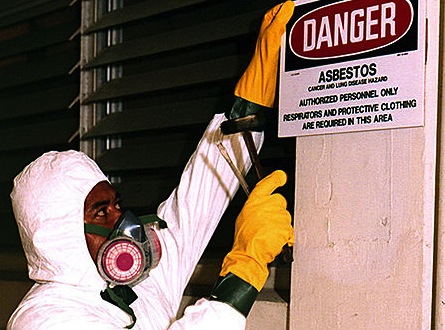Asbestos in America - From World War II to Now
Alda McKnight, January 25 2013
Asbestos is a commonly used insulation material that is acid and fire resistant. It has been utilized in construction around the world for thousands of years. Within the past few decades it was discovered to be extremely harmful. Modern buildings no longer use this type of insulation due to the great risk for cancer and various lung diseases.
Before the risks of asbestos use were widely known or publicized, it was a commonly used insulator in U.S. Navy ships. During World War II the Navy mobilized at a historically unprecedented scale, making indispensable contributions to victory in that war. Unfortunately, hundreds of thousands of sailors and shipyard workers were heavily exposed to asbestos in the process.
A Brief History of Asbestos in Antiquity
Over 2,000 years ago in ancient Greece there existed a substance said to be magical due to its properties. It was resistant to fire, durable, and seemingly indestructible. It was named asbestos, a word meaning "inextinguishable".
Some ancient observers also noticed it caused harm to the body. Strabo, Greek geographer and Pliny the Elder, Roman naturalist, both noted health problems in the slaves that worked with asbestos. They called it "sickness of the lungs", but this illness was ignored because the substance had many useful properties.
In Greece and Rome, asbestos was used for many things. It was used in the eternal flames as their wicks and as funeral dresses for kings during their cremation. Romans used the cloth as napkins claiming it could be cleaned by fire. This cloth would come out of the fire a brighter white color than before it was put in. Romans came up with the name amiantus which means unpolluted.
The U.S. Naval Mobilization for World War II
In the 1930s, asbestos became a popular substance in the U.S. Navy. Used as insulation in ships and in many of the necessary ship parts, it became an integral part of the ship building industry.
As early as 1938, the Navy came under heavy pressure to expand and modernize its fleet. The immediate catalyst was the German aggression in Europe combined with Japanese advances in China. To deter potential aggression against the United States, Congress passed a bill to expand the size of the Navy by 20 percent. As both Germany and Japan continued to expand their territory, an additional act was passed in 1940 that became dubbed the "Two-Ocean Navy Act", with a self-explanatory objective. Overall the U.S. military spent $590 million on naval construction between 1938 and 1945.
Shipbuilding was a labor intensive process. At its height the Boston Navy Yard employed nearly 50,000 workers and had shifts going seven days a week, around the clock. There also immense shipyards constructed or expanded in Portsmouth (N.H.), New York City, Bayonne (N.J.), Philadelphia, Norfolk, Charleston, Seattle, San Francisco, and San Diego.
For the navy alone these bases combined to build over 1,000 ships during the course of the war. The Merchant Marine contributed another 5,000. Many of these were Liberty Ships, made from prefabricated parts shipped to the coasts from around the country. Liberty Ships and Naval ships alike were heavily insulated with asbestos. It is estimated (see UMJ citation in Recommended Reading) that almost a billion pounds of asbestos were used per year during World War II in the United States.
Surgeon General's Warning
As early of 1922 there was a suspicion in the U.S. that asbestos could be the source of various health problems. By 1939, the Navy's Surgeon General had issued warnings of the risks associated with exposure. Some recommendations given in his Annual Report that year were for people working with asbestos to wear masks, and for exhaust fans to be placed in areas where asbestos materials were heavily used. Be it due to cost, ignorance of the dangers, or prioritization of the shipbuilding process over the human cost, these recommendations were not implemented. Not only were they not implemented during World War II, which could be arguably defensible, but they were ignored for decades thereafter.
 Mesothelioma mortality rates by county, 1999. These correlate heavily to the location of naval and merchant marine construction yards. (click for more info)
Mesothelioma mortality rates by county, 1999. These correlate heavily to the location of naval and merchant marine construction yards. (click for more info)In the long-term this use of asbestos insulation cost thousands of lives. The people who came down with asbestos-related diseases overwhelmingly came from the most industrial areas of the U.S., with a special concentration around the coasts where naval ships were built. Indeed, throughout the early 1940s the U.S. military had a near monopoly on American production of the product, and was one of the few employers with the means of exposing workers to the substance.
OSHA and Asbestos Regulations
Asbestos continued to be an often-used insulator in postwar America, resulting in many preventable deaths and illnesses among industrial workers. Women and children at home were also at risk because many men came home with contaminated clothing. It wasn't until the 1970s that regulations were made to change how asbestos was used and decrease exposure.
OSHA, the Occupational Safety and Health Administration, started controlling the use of asbestos in 1971. Unfortunately, this was over 50 years after the first case of asbestosis was made. In 1924, Nellie Kershaw, who had worked with asbestos from the age of 13, died at the age of 33. Her English doctor called the illness "asbestosis" due to the presence of asbestos fibers in the lungs.
The Future of Asbestos
Mesothelioma and asbestosis are the main illness caused directly by asbestos exposure. There are currently no treatments available and no cure has been discovered. Five-year survival rates for mesothelioma are around 10 percent -- and even this bleak number is an improvement from the 1990s and earlier. Overall, it is estimated that asbestos-related diseases have killed at least 150,000 people and potentially many more.
The use of asbestos was subject to a widely-publicized string of lawsuits beginning in the 1970s, in what has been one of if not the longest running mass tort action in American history. Over 700,000 people have been affected with serious or fatal diseases and filed claims or lawsuits for compensation. These have entered a byzantine niche of the legal world, replete with bankruptcy trusts, Supreme Court cases, abortive legislation, and state-by-state differences in court procedure. By the time that the last vestiges of asbestos-related disease disappear (something that will not happen anywhere close to the current date of 2013), it is estimated that asbestos-related litigation will cost around $250 billion.
Modern regulations have advanced the safety of those working in high-risks industries. They have also practically eliminated the use of the substance in products and industries. Sadly, due to the lack of quick action in the past, asbestos in America will continue to contribute to at least 100,000 deaths over the next few decades.
Recommendations/Sources
- Ulster Medical Journal - Asbestos and Ship-Building: Fatal Consequences
- The Navy Department Library - Building the Navy's Bases in World War II


